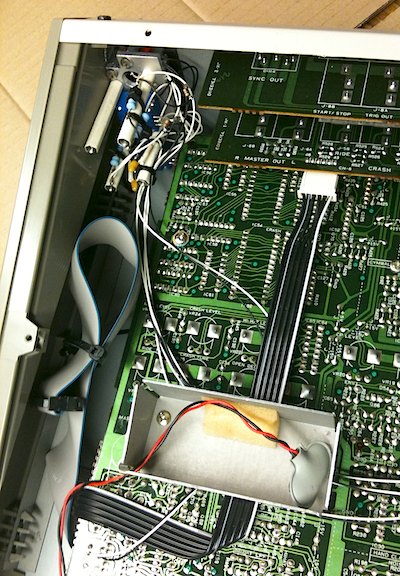TR-909 Modifications
Using Colin Fraser's excellent in depth instructions, and also with the help of C.Y. Kong's TR-909 page, I modified my 909. The result is great. Thank you very much Colin Fraser and C.Y. Kong!
I hope that this page can help you a little bit if you want to modify your 909. (If you do, you do it at your own risk.)
No drilling
I wanted a pitch control knob for the bass drum. But I did not want to drill holes into my 909. I did not want to change it's appearance to much. The only solution I could think of was to put the modifications in the cartridge slot on the back. I did not need it, and the 909 works just fine without it. This before and after photo is how it looks:

The cartridge slot
The problem was to fit knobs and switches in the small 18x59mm hole on the back of the 909 and make it look a bit like the original cartridge slot. If you are going to do this, I think you need to do what I did: Take out the cartridge slot, measure everything, and then figure out how to fit what needs to fit there. I needed 2 knobs and 4 switches. There was just enough room.
I made two panels from aluminium. One to mount the potentiometers and switches on, and the other as a front panel that the knobs and switches come through (painted matte black):

The bottom panel, with components mounted:

The whole thing, mounted inside the 909. It looks better on the outside. The flat cable on the left used to be connected to the cartridge slot:

The modifications
I found it very useful to test different values of capacitors, resistors and potentiometers to hear what the modifications sound like and select the values that gave me the most useful modifications. I connected components temporarily, and played a pattern to hear how they felt together with the other sounds.
Bass drum pitch knob
Replaced resistor R59 (47kΩ) with a 40kΩ resistor and a 25kΩ linear pot, and a switch to switch back to the original resistor.
The original pitch is about 55Hz, now I can adjust it from about 39Hz to 66Hz. This is a pretty small range, and I tried many resistors before I went with 40kΩ. I also tried a 50kΩ pot, but found it too sensitive and it was hard to set the pitch just right.
This is first the original pitch, then the pitch knob turned from it's highest to lowest position:
bassdrum-pitch.mp3
Bass drum extended tune range
Added 0.33µF in parallel with capacitor C9, and a switch to turn it off.
I sometimes turned the tune knob all the way up, but still wanted more. Depending on the revision of your 909, C9 could be 0.22µF or 0.33µF. Mine has 0.33µF. Colin Fraser describes a more proper way to do this, this way has a...
Side effect: The bass drum sounds a little less tight. I'm not sure, but I think this is because increasing C9 will make the attack and decay time of the pitch envelope longer, not only the decay time. I actually like this effect, and I can switch off when I don't want it.
This is first the unmodified tune knob at maximum, then with the modification enabled:
bassdrum-tune.mp3
Bass drum extended decay range
Added 1µF in parallel with C8 (0.33µF), and a switch to turn it off.
This makes the decay go up to about 2 seconds. Now it can boom like a 808.
Side effect: It appears to also increase the volume envelope attack time. Just a little bit.
This is first the unmodified maximum decay, then with the modification enabled:
bassdrum-decay.mp3
Hi-hat pitch knob
Replaced resistor R492 (12kΩ) with a 6.8kΩ resistor and 10kΩ linear pot, and a switch to switch back to the original resistor.
This gives the hi-hat a tune knob to change it's pitch, like the crash and ride cymbals have. As far as I can tell, the ride and crash also use a 6.8kΩ resistor and 10kΩ linear pot, and the result is similar.
Alternative: Sample the hi hats, and play back the samples at whatever pitch you like. It sounds the same.
This is first the original pitch, then the pitch knob turned from it's highest to lowest position:
hihat-pitch.mp3